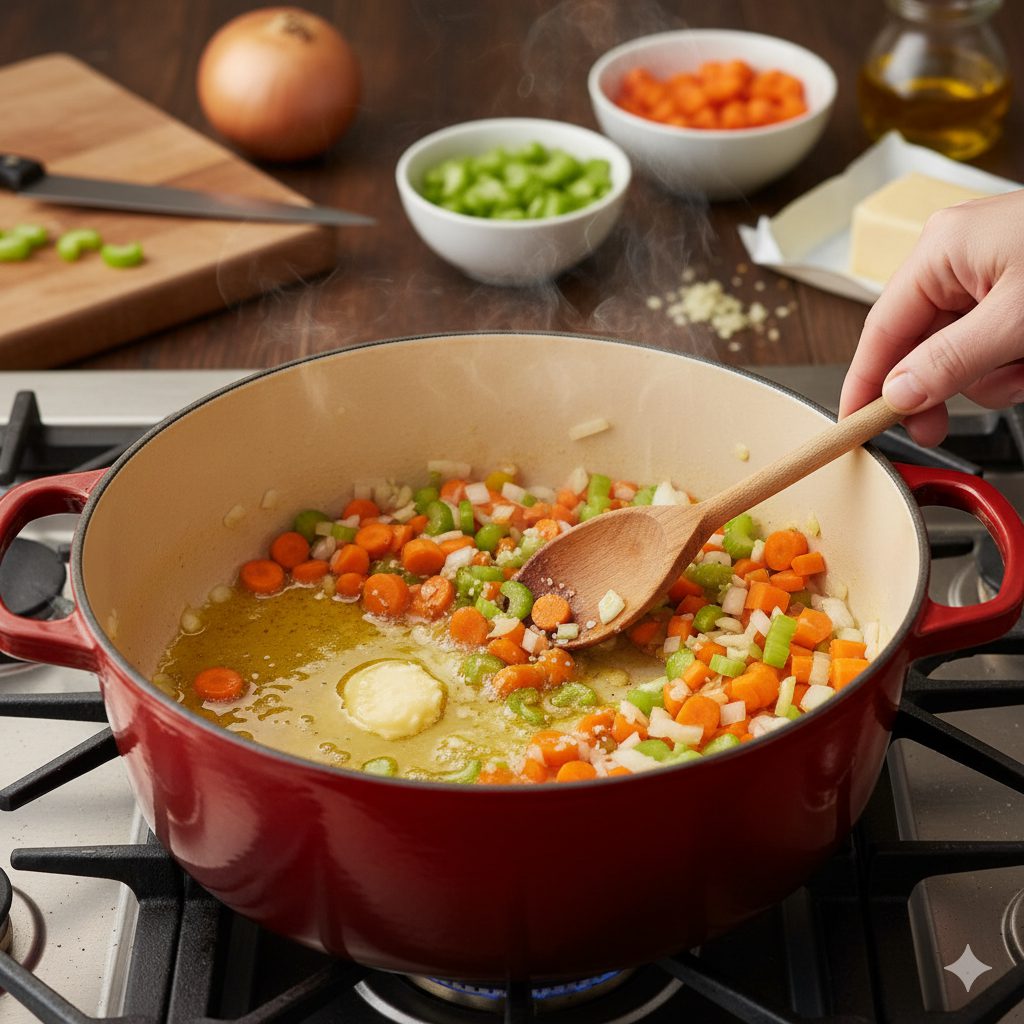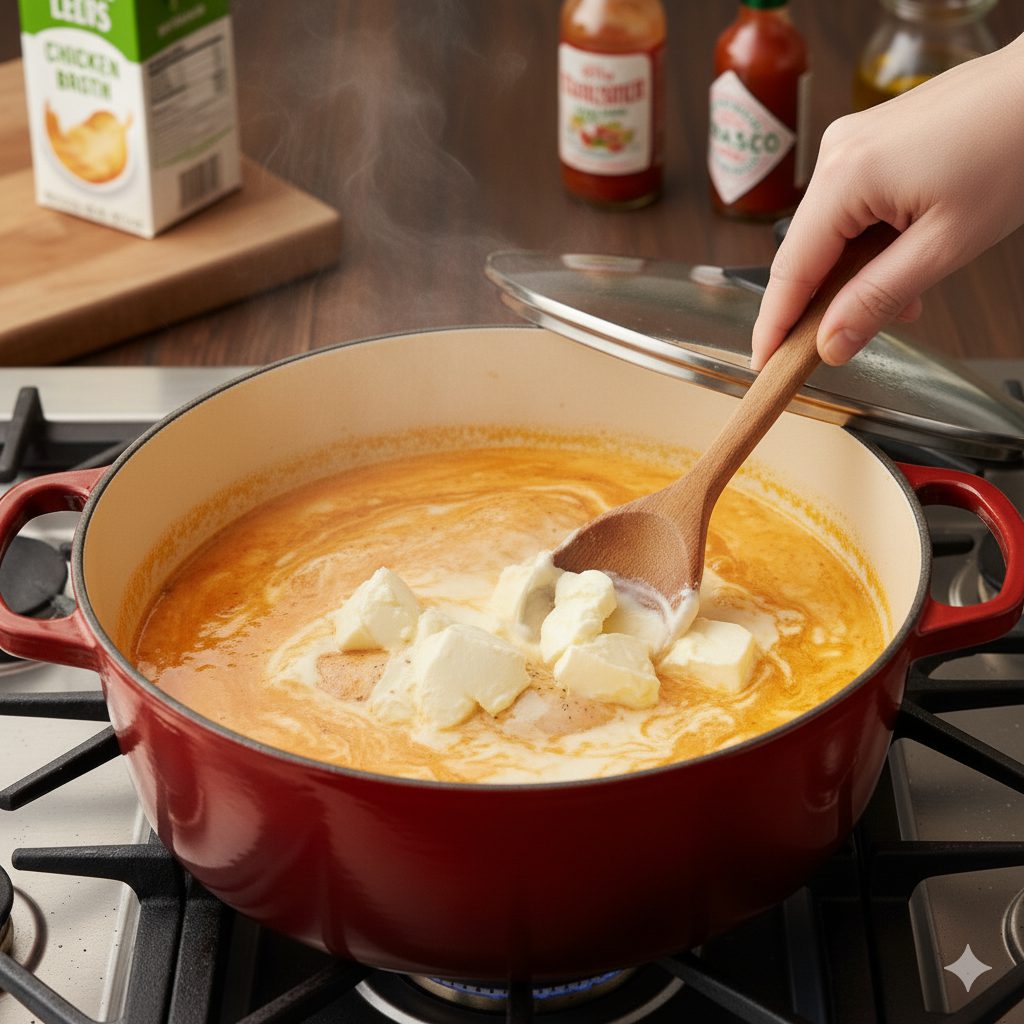Note
The essence of Buffalo Chicken Soup lies in capturing the intense, tangy, and creamy flavor profile of a classic chicken wing and transforming it into a hearty, comforting bowl. Achieving this balance requires more than just mixing hot sauce and chicken; it’s about layering flavors, mastering texture, and offering a creative presentation.
Expert Tips and Insider Tricks
Creating a truly exceptional Buffalo Chicken Soup starts with intentional cooking decisions that deepen the flavor and refine the texture.
1. Building the Savory Foundation: The traditional French technique of mirepoix (sautéed onions, carrots, and celery) is your non-negotiable flavor base. The trick is to sauté these vegetables in butter for an extended period—about 8 to 10 minutes—until they are significantly softened and slightly caramelized. This step mellows their raw bite and creates a savory depth that simple boiling cannot achieve. For an extra layer of complexity, add minced garlic and a teaspoon of tomato paste after the vegetables have softened, cooking for just one more minute to bloom their flavors.
2. The Texture Tactic (No Graininess Allowed): A creamy soup requires a smooth emulsification. Cube it into small pieces and add it only after the soup has been removed from the direct, rolling boil. Whisk the cream cheese in until it is completely dissolved and the soup is uniform. For the final thickening, consider making a cornstarch slurry (a mix of cornstarch and cold water) rather than adding flour directly, as a slurry blends more reliably without clumping.
3. The Heat and Herb Balance: Buffalo sauce is complex, combining cayenne pepper, vinegar, and butter. Start with the suggested amount of cayenne-based hot sauce, then taste and adjust the heat right at the end of cooking. A critical trick is the introduction of ranch or blue cheese seasoning mix. Instead of using a liquid dressing, the powdered seasoning mix provides the classic herby, tangy notes without thinning out your soup base.
4. Chicken Choice and Preparation: To save time and add richness, use shredded rotisserie chicken, incorporating both white and dark meat for superior flavor. This infuses the stock with extra chicken flavor before you even start the main recipe. Shred the chicken pieces using two forks or a stand mixer for quick, perfectly uniform shreds.
Serving Tricks and Presentation
The true enjoyment of Buffalo Chicken Soup comes with the final flourishes. Treat the bowl as a canvas to enhance the flavors and textures.
1. The "Cooling Contrast" Toppings: The best counterpoint to the soup's heat is a refreshing, cool, and crunchy topping. Offer a mini-bar of toppings for personalization:
- Blue Cheese Crumbles: The essential pairing, offering a sharp, pungent bite.
- Fresh Crunch: Finely diced celery, shredded carrot, or chopped green onion/chives.
- Dairy Cool Down: A dollop of sour cream or Greek yogurt swirled on top.
- The Unexpected Crisp: Crushed plain or blue cheese-flavored tortilla chips or small, crunchy croutons for an added textural dimension.
2. Dippers and Sides: Serve the soup with substantial items for dipping.
- Cheesy Bread: Toasted ciabatta or baguette slices topped with melted provolone or mozzarella.
- Soft Pretzel Bites: The slight saltiness of a soft pretzel is a perfect complement.
- A Palate Cleanser: A small side of a crisp, sweet salad like a coleslaw or a Waldorf salad to cut the heat between spoonfuls.
Flavor Variations and Customization
This soup is an excellent base for creativity. You can shift the flavor profile dramatically with just a few ingredient swaps.
1. The "Fully Loaded" Variety: For a heartier, nearly stew-like consistency, introduce starchy elements. Add cubed potatoes (Yukon Golds are ideal) or a cup of small pasta like ditalini or elbow macaroni along with the chicken broth. Ensure the potatoes or pasta are cooked until tender before adding the creamy elements.
2. Heat and Smoke Infusion: Substitute one-third of the regular chicken broth with smoked chicken stock or a very light beer. Alternatively, add a teaspoon of smoked paprika or a chipotle pepper (minced) for a deep, smoky undertone that enhances the buffalo flavor.
3. Vegetarian/Plant-Based Adaptation: The base can easily be converted by substituting the chicken with canned chickpeas (garbanzo beans) or cannellini beans, and using vegetable broth. For the creaminess, a combination of full-fat coconut milk and nutritional yeast can mimic the richness of the dairy.
Storage and Reheating Integrity
Because of the dairy content, careful storage and reheating are key to maintaining the smooth texture.
1. Refrigeration: Refrigerated soup is best consumed within 3 to 4 days.
2. Freezing (Use Caution): If you plan to freeze portions, it is a superior strategy to make the soup without the cream cheese and cheddar and stir them in fresh after thawing and reheating the broth and chicken base. The soup can be safely frozen for up to 2 to 3 months. Always leave about an inch of headspace in your container for expansion.
3. Reheating: If the soup is too thick, incorporate a splash of extra chicken broth or milk while warming to return it to the desired consistency. Avoid rapid, high-heat boiling, especially in the microwave, which can encourage the dairy to break.
Conclusion
Buffalo Chicken Soup is more than just a passing trend; it is a culinary experience that combines comfort food textures with the thrilling, iconic flavor of a tailgate favorite. By focusing on the essential techniques—fully softening the aromatics, ensuring a smooth dairy blend, and judiciously balancing the heat with herbaceous seasonings—you can elevate a simple soup into a memorable meal. The final presentation, featuring crunchy toppings and cooling dips, transforms the serving into an interactive and customizable delight. This soup stands as a testament to the powerful, satisfying synergy of bold spice and creamy richness, solidifying its place as a cold-weather classic.







